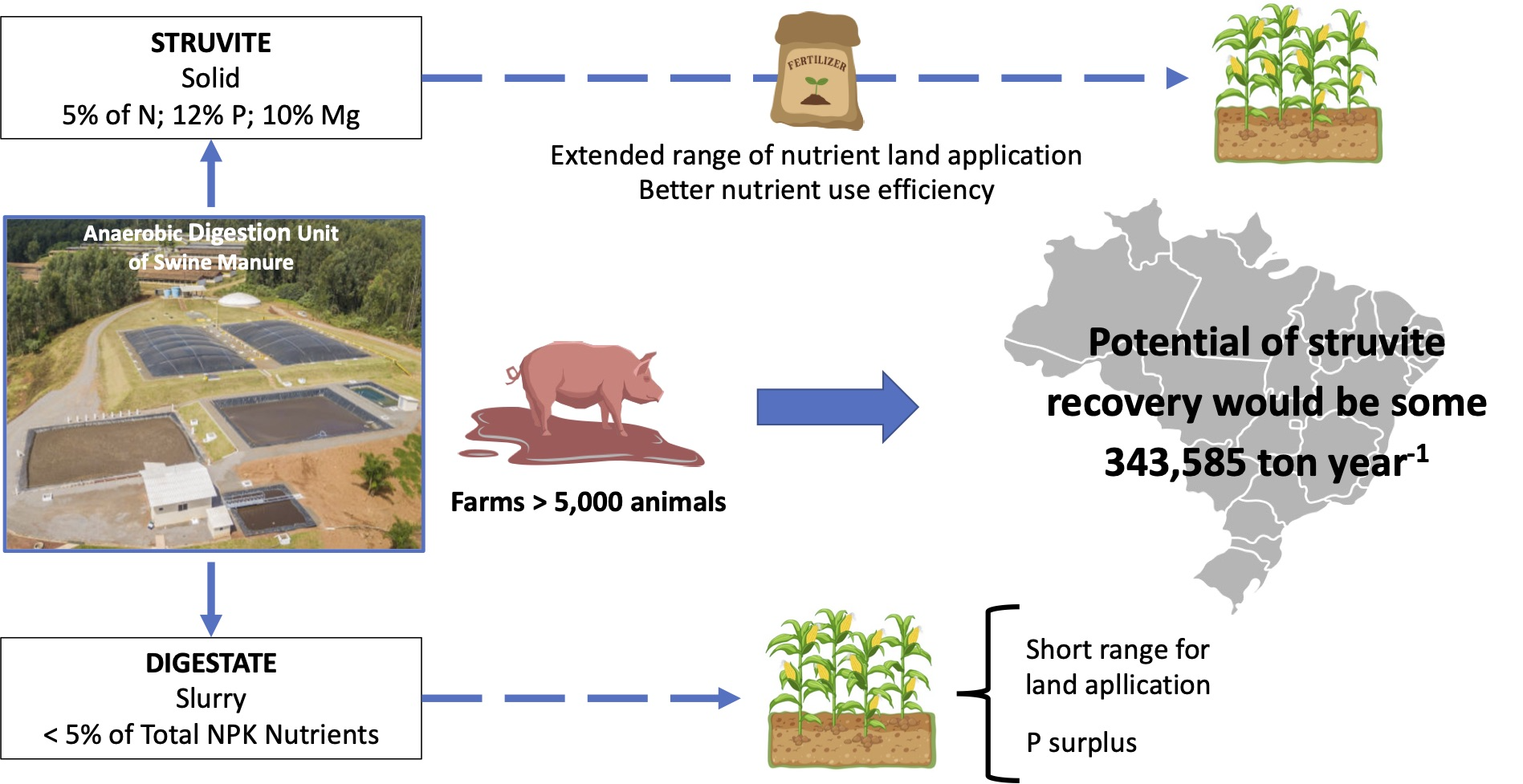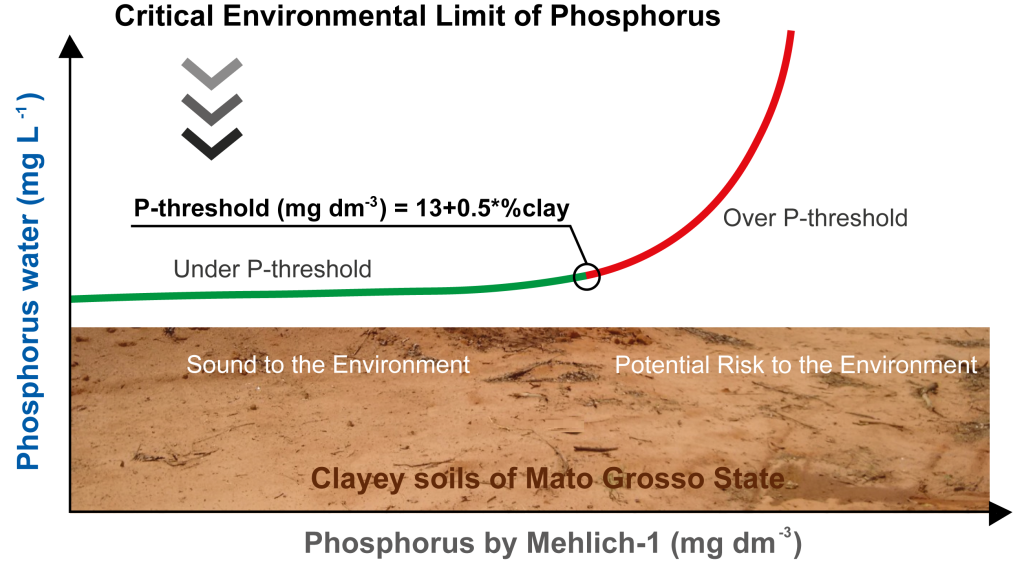Struvite potential as a slow-release fertilizer for phosphorus sustainable management in Brazilian agriculture
12/Sep/2025
ABSTRACT Phosphorus in agriculture is an essential, limited, and strategic resource, and its sustainable management is a global challenge. Phosphorus (P) recovery as struvite (NH4MgPO4.6H2O) from manures and municipal and agro-industrial wastewaters has been considered one of the most sustainable technologies, based on the circular economy, to face challenges regarding P reserves and its use for conventional fertilizer production. Struvite is a slow-release P-fertilizer (5 % N, 12 % P, 10 % Mg), which could significantly reduce the Brazilian dependency […]
Establishing environmental soil phosphorus thresholds to mitigate its transfer to water bodies in Mato Grosso State, Brazil
28/Nov/2023
ABSTRACT Excessive phosphorus (P) applications can increase nutrient levels in the soil, facilitating its transference to aquatic environments and causing contamination. Thus, the environmental P threshold (P-threshold) is a tool to establish a sound level of P in the soil, in which P values below the threshold are harmless to the environment. This study aimed to establish a P-threshold equation for the soils of Mato Grosso State, Brazil. Twenty samples of representative soils from the main swine production regions of […]
SOIL PHOSPHORUS THRESHOLDS IN EVALUATING RISK OF ENVIRONMENTAL TRANSFER TO SURFACE WATERS IN SANTA CATARINA, BRAZIL
01/Jul/2015
The State of Santa Catarina, Brazil, has agricultural and livestock activities, such as pig farming, that are responsible for adding large amounts of phosphorus (P) to soils. However, a method is required to evaluate the environmental risk of these high soil P levels. One possible method for evaluating the environmental risk of P fertilization, whether organic or mineral, is to establish threshold levels of soil available P, measured by Mehlich-1 extractions, below which there is not a high risk of […]
Ammoniacal nitrogen immobilization from pig slurry in soil under reduced and no-tillage
01/Feb/2009
The use of pig slurry in no-tillage systems on cultural residues with high C/N ratio is becoming a common practice in the center-south of Brazil. Two experiments were conducted to evaluate the immobilization of ammonium N applied with pig slurry to the soil. One experiment was run in the field and the other in laboratory conditions, both on a Hapludalf soil. The treatments consisted of pig slurry application with and without oat straw, with (reduced tillage) and without (no-tillage) soil […]
Soil phosphorus forms after successive pig slurry application in a native pasture
01/Aug/2008
The swine industry generates large amounts of pig slurry (PS), which is reused as agricultural fertilizer. However, if applied at excessive rates, pig slurry becomes a severe environmental pollutant. The objective of this study was to evaluate forms of soil phosphorus accumulation after successive swine manure applications. The experiment was installed in 1995, in an area of native pasture. Rates of 0, 20 and 40 m3 ha-1 of PS were applied periodically (at 45 to 60 days intervals) during five […]
Soil macrofauna as influenced by chemical fertilizers and swine manure use in western Santa Catarina State, Brazil
01/Apr/2008
The present study aimed to evaluate the effect of addition of increasing rates of swine manure, mineral fertilizers, and the combination of both on the abundance and diversity of soil macrofauna. The study was carried out in Campos Novos county, in the western Santa Catarina state, on an Oxisol cultivated with corn (Zea mays) and oat (Avena sativa) in succession and no tillage system. Six treatments were used: a control, with no fertilization (TT); mineral fertilization (AM); swine manure + […]
Deep-Litter and pig slurry as nitrogen sources for corn
01/Feb/2008
Most of the pig manure generated in the swine production in southern Brazil is handled and stored as liquid manure, but there is a growing interest in adopting the deep-litter production system and using the resulting organic material as fertilizer. A field experiment was carried out on a typic Hapludalf in an experimental area of the Universidade Federal de Santa Maria, Santa Maria, state of Rio Grande do Sul, from October 2002 to March 2003, to evaluate the soil N […]
Performance of at and italian rye-grass mixture and soil chemical attributes as related to liquid swine manure application
01/Dec/2007
Dry matter production of winter annual pastures is usually low due to the limited soil nutrient availability, which can be amended by the use of liquid swine manure (LSM). This experiment, carried out from May to November 2003, aimed to evaluate the efficiency of LSM in the production and accumulation of dry matter, and N-leaf concentration of an oat/Italian rye grass mixture, as well as the effect on some chemical attributes of an Oxisol in the soil layers 0-5, 5-10 […]
Influence of successive additions of zinc from swine manure or ZnO, on corn dry matter yield
01/Dec/2001
Part of the swine manure from confined production is still improperly disposed into water streams and small rivers in southern Brazil. An alternative disposal method would be to use this animal residue as a soil fertilizer. However, repeated applications in the same area may cause nutrient build up to phytotoxic levels and could lead to surface and subsurface water pollution. The objective of this study was to evaluate the effect of Zn addition to the soil on corn dry matter […]


